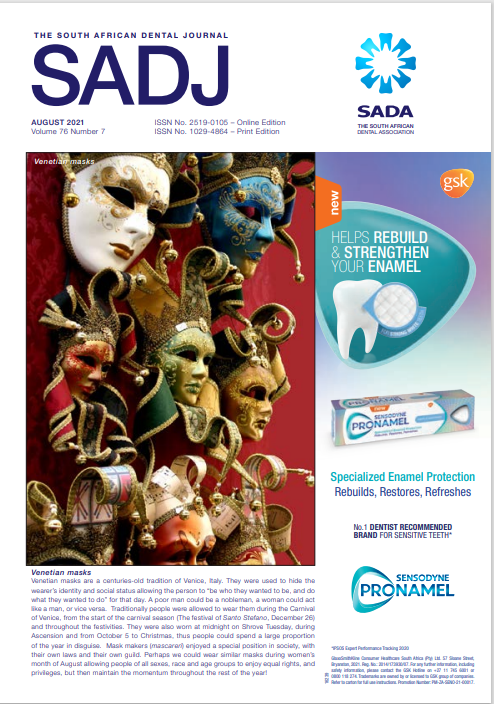An overview of COVID-19 infection in dental practices - a questionnaire survey
DOI:
https://doi.org/10.17159/2519-0105/2021/v76no7a2Keywords:
dental-generated aerosol s., meta-analysisAbstract
Dental nurses and practitioners are at high risk of exposure to COVID-19 due to physical proximity and exposure to body fluids during treatment. Dental practices have implemented multiple protective protocols to decrease COVID-19 transmission; however, it is difficult to evaluate how effective these measures are, as there is limited data on COVID-19 in dental practices. To evaluate COVID-19 infection rates among dentists, dental staff, and patients in different countries through an online survey, with a primary focus on South Africa (SA). Cross-sectional online survey. One hundred fifty-four participants from 52 countries answered the survey, 48.6% (n=561) from SA. COVID-19 infections were reported in 18.2% (n=210) of dental practices. Only 1.1% regarded the practice as the source of infection for dentists and staff who got infected. In total, 13.9% (n=160) treated COVID-19 patients. SA presented a higher infection rate (19% vs 13%, p=0.04) and more frequent treatment of COVID-19 patients than the other countries combined (17% vs 11%, p=0.006). These findings support the need to maintain strict infection control measures to decrease transmission of SARSCoV-2 during the delivery of oral care.
Downloads
References
Jamal M, Shah M, Almarzooqi SH, et al. Overview of transnational recommendations for COVID-19 transmission control in dental care settings. Oral Dis. 2020;00;1-10. doi: doi.org/10.1111/odi.13431.
Peng X, Xu X, Li Y, Cheng L, Zhou X, Ren B. Transmission routes of 2019-nCoV and controls in dental practice. International Journal of Oral Science. 2020; 12: 1-6. doi: doi.org/10.1038/s41368-020-0075-9.
World Health Organization. Considerations for the provision of essential oral health services: Interim Guidance 2020, 3 August 2020. World Health Organization. https://apps.who.int/iris/handle/10665/333625. License: CC BY-NC-SA 3.0 IGO.
UK Office for National Statistics. Which occupations have the highest potential exposure to the coronavirus (COVID-19)? 2020. Available from: https://www.ons.gov.uk/employmentandlabourmarket/peopleinwork/employmentandemployeetypes/articles/which occupations have the highestpotentialexposuretothecoronaviruscovid19/2020-05-11.
Brian Z, Weintraub JA. Oral Health and COVID-19: Increasing the need for prevention and access. Prev Chronic Dis. 1 Aug 2020; 17: 200266. doi: 10.5888/pcd17.200266.
Centers for Disease Control and Prevention Guidance for Dental Settings. Interim Infection Prevention and Control Guidance for
Dental Settings During the COVID-19 Response. 4 Dec 2020. Available from: https://www.cdc.gov/coronavirus/2019-ncov/hcp/dental-settings.html
American Dental Association. ADA COVID-19 Center for Dentists 2020. Available from:https:/ /success.ada.org/en/practicemanagement/ patientsinfectious-diseases-2019-novel-coronavirus.
Estrich CG, Mikkelsen M, Morrissey R, et al. Estimating COVID-19 prevalence and infection control practices among US dentists. J Am Dent Assoc. 2020;151(11):815–24. doi: 10.1016/j.adaj.2020.09.005.
Conselho Federal de Odontologia. Relatório - COVID-19 - Odontologia. 2020. Available from: https://website.cfo.org.br/ wp-content/uploads /2020 / 07/Relatório-covid19-OdontologiaCirurgioes-Dentistas-1.pdf.
Li Y, Ren B, Peng X, et al. Saliva is a non-negligible factor in the spread of COVID-19. Molecular Oral Microbiology. 2020; 35:
-5. doi: 10.1111/omi.12289.
Toulis P. Estimation of Covid-19 Prevalence from Serology Tests: A Partial Identification Approach. J Econom. 2021; 220(1): 193-213. doi: 10.1016/j.jeconom.2020.10.005.
Houlihan CF, Vora N, Byrne T, et al. Pandemic peak SARS= -CoV-2 infection and seroconversion rates in London frontline
health- care workers. The Lancet. 2020; 396: e6-7. doi: 10.1016/S0140-6736(20)31484-7.
Gómez-Ochoa S, Franco O, Rojas LZ, et al. COVID-19 in health-care workers: a living systematic review and metaanalysis of prevalence, risk factors, clinical characteristics, andoutcomes. Am J Epidemiol. 2020; 190(1): 161-75. doi: 10.1093/aje/kwaa191 doi: 10.1111/idj.12332.
Lakshmi Priyadarsini S, Suresh M. Factors influencing the epidemiological characteristics of pandemic COVID 19: A TISM approach. Int J Healthc Manag. 2020; 13(2): 89-98. doi: doi.org/10.1080/20479700.2020.1755804.
Moraes RR, Correa MB, Queiroz AB, et al. COVID-19 challenges to dentistry in the new pandemic epicenter: Brazil. PLoS One. 2020; 15(11): e0242251. doi: 10.1371/journal.pone.0242251.
Casado PL, Quinelato V, Cataldo P, et al. Dental genetics in Brazil: Where we are. Molecular Genetics and Genomic Medicine. 2018; 6: 689-701. doi: 10.1002/mgg3.457.
Bhayat A, Chikte U. The changing demographic profile of dentists and dental specialists in South Africa: 2002-2015. Int Dent J. 2018; 68(2): 91-6.
Parupudi T, Panchagnula N, Muthukumar S, Prasad S. Evidence-based point-of-care technology development during the COVID-19 pandemic. Biotechniques. 2021; 70(1): 58-67. doi: 10.2144/btn-2020-0096.
Dinnes J, Deeks JJ, Adriano A, et al. Rapid, point-of-care antigen and molecular-based tests for diagnosis of SARSCoV-2 infection. Cochrane Database Syst Rev. 2020; 8: CD013705. doi: 10.1002/14651858.CD013705.
Mbunge E. Integrating emerging technologies into COVID-19 contact tracing: Opportunities, challenges and pitfalls. Diabetes
Metab Syndr Clin Res Rev. 2020; 14(6): 1631-6. doi: 10.1016/j.dsx.2020.08.029.
Dye BA. The Global Burden of Oral Disease: Research and Public Health Significance. J Dent Res. 2017; 96(4): 361-3. doi: 10.1177/0022034517693567.
Banakar M, Bagheri Lakarani K, Jafarpour D, Moayedi S, Banakar MH, Mohammadsadeghi A. COVID-19 transmission risk and protective protocols in dentistry: A systematic review. BMC Oral Health. 2020 Oct 8; 20(1): 275. doi: 10.1186/s12903-020-01270-9.
Korber B, Fischer WM, Gnanakaran S, et al. Tracking Changesin SARS-CoV-2 Spike: Evidence that D614G Increases Infectivity of the COVID-19 Virus. Cell. 20 Aug 2020; 182(4): 812-27.e19. doi: 10.1016/j.cell.2020.06.043.
Downloads
Published
Issue
Section
License

This work is licensed under a Creative Commons Attribution-NonCommercial 4.0 International License.






.png)